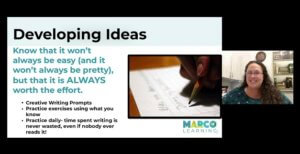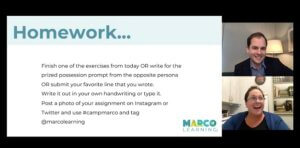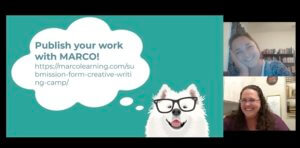How an Online Creative Writing Course Restructured My Online Teaching Philosophy
by Heather Garcia
I have never been a fan of relying on technology in the classroom. I am a fan of paper and pretty pens, and that translates to my teaching. We annotate books with pens (to the horror of some of my peers), I grade papers that are handwritten (since the AP® tests are traditionally handwritten), and most of the classroom assignments that the students complete are handwritten. I obviously rely on a computer for email and for typing articles and paying bills. I have a smartphone and use social media. I am not a total tech-nube, but in the classroom, I have always preferred to keep it old school. I just never thought that online engagement could compare to in-person, traditional engagement—and then we had a pandemic.
In a matter of weeks, the entire world was held behind the veil of computer screens. Virtual field trips, virtual round-table discussions, and virtual PD. I still wasn’t convinced, but as a professional, I dove in. I had no choice. After nine weeks of struggling to engage my students virtually, I was exhausted and frustrated and SO ready for summer break.
But I love a challenge, and I love writing, and I love students, so I asked Marco Learning if I could host a free Creative Writing Camp for middle and high school students for two weeks over the summer…and they let me. I cannot oversell how much this experience changed the way I approach online learning and online teaching. I had a genuine epiphany. Once I distanced myself from grades, test prep, and the pressure of everything that goes with “education” and just focused on the joy of building an online community of learners, my opinion towards online learning drastically shifted.
This online course had 359 students enrolled, and I was struggling to find a way to ensure that their voices were all heard, that they felt valued in the course, and that they learned and grew as writers—all things that we want in our classrooms.



The strategies that I experimented with created engagement levels that I didn’t expect.
The strategies that I used are not revolutionary—but they were to me. Transitioning from an in-person classroom philosophy that was 16 years in the making to an online teaching philosophy that only had weeks to germinate was a challenge. Since I am certain that I am not alone, I want to take some time to outline what worked for this online course because as we dive into the 2020-2021 school year, MANY of us will be teaching students we haven’t met face to face. Below are the strategies and techniques that I used with over 350 students that I had never physically met:
Open with Five Minutes of Teaching: I limited the amount of time I spent in lecture so that I had mini-skills-lessons. I introduced a skill, for example, showing vs. telling. I then showed the students a sample that I had created and offered students a second awful sentence to fix on their own. After about three minutes of writing, they would type their better sentence versions into the online chatbox. I used their sentences as my teaching material. I would read some of the sentences as they came in. I would praise, offer suggestions, tell the students how fantastic their responses were, and then we would move on to a longer exercise. I didn’t need to create endless samples and dozens of slides, the kids did that for me, and it was WAY better than anything I could have created. They were invested, and we all learned from each other.

Explain Exercises: Once we went through the teaching and short exercise portion of the class, I assigned a longer exercise that students would work on. I gave them step- by-step directions, and I left the exercise instructions on the slide while students worked. I warned them that they had 10-15 minutes to work, and then I would start the timer.
Allow 10-15 Minutes for Creation: I never had the kids working for more than 15 minutes. For an online course, it was just too long (and in retrospect, 10 minutes was usually enough time). What worked during this time is that I left my camera and microphone on. I cheered them on and gave them time updates every four or so minutes. I said enough to remind them that I was there, but not enough to disrupt them. I also wrote when they did. If they looked at their screen, they saw me in the corner—or rather, they saw the top of my head as I was looking down, writing right alongside them. I was in the trenches with them. We were writers together in the same space at the same time, and when I made mistakes, they heard me scribble with my pen, they heard me rip off pages and start over. I was real and open with them, and in return, they were real and open with me. In the classroom, while students are working, I was usually grading assignments or taking attendance or checking email- completing tasks that needed to happen—but not at that exact moment. But with this class, for these few minutes, I just focused like I asked the students to do, and that was a game changer for student engagement.

Facilitate a Share Out: Once the writing time was over, I encouraged students to type into the chatbox. I knew that I couldn’t read 15 minutes of writing from over 350 kids at once, so I asked them to type in their favorite line from the exercise or to type in their first-line. I obviously didn’t read each sentence that came in, but I read some as they populated the screen. I encouraged the students to scroll through the chat and find some that they liked and to comment on them. Some of my favorite student samples came when I asked them to find their worst sentence and then take a few minutes to rewrite it, then post the original and revised versions. I did all of this with them. I typed in my lame sentences or I typed in my opening sentences and had kids tell me how to improve them (they were usually spot-on with their critique). The community that we built through sharing our writing was invaluable, and one that I rarely glimpsed in the traditional classroom. The way that I was running my in-person classroom produced amazing students and rich discussions, but not the engagement and community that this mix of strangers were able to create within the first virtual class session.
Incorporate a Discord Server: I will be honest, I didn’t even know what a Discord server was until John Moscatiello, the Founder of Marco Learning, set it up. During the first class session, the students were having so much fun sharing in the chat that they wanted to create a shared platform outside of “class time” so they could continue to get to know each other and chat. I started to panic—the teacher in me wanted to control it, to harness the discussion, to keep it within the class sessions, but John did the exact opposite. He created a Discord group for the students to chat in. He gave them a link, gave them a platform, and the teacher in me was mortified. What if they said something mean? What if a poem they posted was inappropriate? But, my worries were unfounded. The kids who chose to log in were respectful of each others’ work. They praised each other, encouraged each other, shared, and celebrated. They were the most uplifting group of teenagers ever, and I was blown away.
Embracing Social Media: As an educator, I am a huge fan of reflecting on what we learn and expanding on it through homework, but I couldn’t very well grade hundreds of writing pieces each night. There just isn’t enough time in the day. But just like with my AP® courses, I know that homework is an important extension of the classroom experience, so I knew I had to assign it, even for this free creative writing course. Thankfully, John guided me here as well (seriously people, it took some intense hand-holding and nudging to get me to this epiphany-moment). Using the Instagram hashtag, #campmarco, students were able to take pictures of their work, many enhanced with calligraphy and illustrations, and post them for the world, and the class community, to see. The work these students produced and posted blew me away. Not everyone chose to do the homework, some chose to post in Discord for a smaller audience, some never posted at all (but isn’t that how homework always goes?). I was able to quickly read beautiful student work, respond with hearts and comments from my phone, and connect with my students in a way that was authentic for them. I didn’t need 40 minutes of extra assignments for students to take ownership of their writing. They were able to write one sentence, or one paragraph, or one poem, and post that.

Posting My Work Too: I posted my own work on Instagram using the #campmarco as well. It was a first for me. I have never posted my personal writing, certainly not my drafts, in a public forum. By putting my own creative work out there too, making myself vulnerable to criticism like I expected the students to, it enhanced the sense of community that was already being created in the classroom. I have never, ever, in my entire 16-year teaching career, used social media in a homework assignment. I was always too afraid to dive into the online world with my students. However, these optional homework assignments taught me more about my students (and myself) than I ever thought possible, especially when I participated with them.
Create an Atmosphere: Through constant praising and endless cheerleading, the students realized that this is the only acceptable way to respond to another student’s writing. I had to model the behavior, and then they followed suit. In a traditional classroom, there aren’t as many immediate opportunities for this kind of feedback, so this was a paradigm-shifting moment for me. Now I am thinking of ways that I can more quickly gather work if we are in physical classrooms in the fall. Index cards without names? Post-it notes that get handed in right away? What I don’t want to lose is that immediate positive reinforcement when students complete work, because that is infinitely better than the feedback I write on a paper that students get back a week after they have written it. The power of this immediate feedback is a strong way to build increased engagement.
Utilize Polls: I have always been a fan of concensograms in my classroom. When teaching was in person, I would hand the kids a little round magnet and have them participate on their way out the door. With a quick placement of a magnet they could show me how comfortable they were with content, whether they were enjoying a book, or even whether they actually tried on their homework the previous night. I didn’t think that this would lend itself to online learning; however, I was wrong. The poll feature on Big Marker, the webinar platform used by Marco Learning, allowed me to type in a poll, allowed students to answer it, and for students to see where everyone else stands—all without leaving their seats. It was faster than any poll I have ever been able to conduct in my physical classroom, and the students were engaged.
My hope is that you are able to take at least one of these ideas into your classroom, be it virtual or in person, in the fall. I am certain that these are not new revelations for teachers who have been embracing technology for far longer than I have been, but for me, these revelations shifted the way I view a successful implementation of a course online. This experience took me away from my physical classroom, away from what I thought online teaching was and opened my eyes to what online teaching can be. It refreshed my soul and left me far less apprehensive about the prospect of teaching online again.

Heather Garcia is an English teacher at Charlotte High School, Florida, where she teaches AP English Literature and AP® English Language. She is a professional development leader in her district, running annual new-teacher trainings and is now the Curriculum and Instructional Specialist for her district for grades 6-12. After 16 years of hands-on experience, Heather has developed a series of strategies to help her students navigate challenging texts. Her favorite book is the Steinbeck classic, East of Eden.
 Help
Help